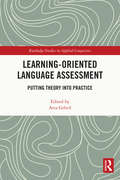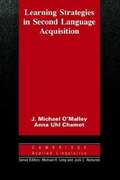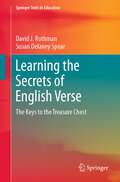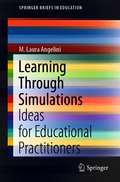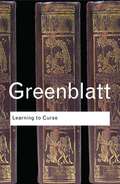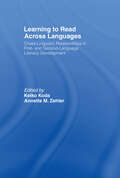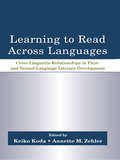- Table View
- List View
Learning Language and Culture Via Public Internet Discussion Forums
by B. Hanna J. De Nooy Juliana De NooyPublic Internet discussion forums offer opportunities for intercultural interaction in many languages on a vast range of topics, but are often overlooked by language educators in favour of purpose-built exchanges between learners. The book investigates this untapped pedagogical potential.
Learning Languages, Learning Life Skills: Autobiographical reflexive approach to teaching and learning a foreign language (Educational Linguistics #8)
by Riitta JaatinenThis book offers an autobiographical reflexive approach to foreign language education. It offers unique ways of developing vocational language teaching as an integrated holistic approach combining language contents with vocationally relevant topics and the interactive, dialogical processes of working in language classes. It is presented in a "common sense" way and accessible to non-native English readers.
Learning Legacies: Archive to Action through Women's Cross-Cultural Teaching (The New Public Scholarship)
by Sarah R RobbinsLearning Legacies explores the history of cross-cultural teaching approaches, to highlight how women writer-educators used stories about their collaborations to promote community-building. Robbins demonstrates how educators used stories that resisted dominant conventions and expectations about learners to navigate cultural differences. Using case studies of educational initiatives on behalf of African American women, Native American children, and the urban poor, Learning Legacies promotes the importance of knowledge grounded in the histories and cultures of the many racial and ethnic groups that have always comprised America’s populace, underscoring the value of rich cultural knowledge in pedagogy by illustrating how creative teachers still draw on these learning legacies today.
Learning-Oriented Language Assessment: Putting Theory into Practice (Routledge Studies in Applied Linguistics)
by Atta GebrilThis collection brings together research on learning-oriented language assessment from scholars working across geographic and educational contexts, highlighting the opportunities of assessment practices which seek to better align assessment and learning tasks and support effective learning. The volume begins by introducing learning-oriented assessment (LOA) and the context around its growing popularity, especially in accountability-oriented settings which favor summative large-scale tests. The first part of the book charts the development of LOA’s theoretical and conceptual underpinnings, outlining the ways in which they have been informed by theories of learning and key elements. The second part demonstrates LOA in practice, drawing on examples from different countries and instructional settings to explore such topics as the role of technology in LOA and developing feedback materials based around LOA principles and developed for core literacy skills.Offering a holistic view of learning-oriented assessment and the real-world affordances and challenges of its implementation, this book is key reading for graduate students, researchers, and practitioners in language testing and assessment, TESOL, and language education.
Learning-Oriented Language Assessment: Putting Theory into Practice (Routledge Studies in Applied Linguistics)
by Atta GebrilThis collection brings together research on learning-oriented language assessment from scholars working across geographic and educational contexts, highlighting the opportunities of assessment practices which seek to better align assessment and learning tasks and support effective learning. The volume begins by introducing learning-oriented assessment (LOA) and the context around its growing popularity, especially in accountability-oriented settings which favor summative large-scale tests. The first part of the book charts the development of LOA’s theoretical and conceptual underpinnings, outlining the ways in which they have been informed by theories of learning and key elements. The second part demonstrates LOA in practice, drawing on examples from different countries and instructional settings to explore such topics as the role of technology in LOA and developing feedback materials based around LOA principles and developed for core literacy skills.Offering a holistic view of learning-oriented assessment and the real-world affordances and challenges of its implementation, this book is key reading for graduate students, researchers, and practitioners in language testing and assessment, TESOL, and language education.
Learning Portuguese as a Second Language (SpringerBriefs in Education)
by Sandra FigueiredoThis volume examines the specific effects that schools have on the performance of immigrant students and linguistic minority groups. Especially in the European context this study fills a gap in examining the effects that schools have on these students’ performance and performance differentiation, taking into account school related factors such as resources and teachers, and the influence of other variables like mother tongue and socioeconomic status. This report on an ongoing research project in Portugal examines state schools within the same district, in the same tests over the same assessment period. The study is based on the following set of relationships: between schools that administer proficiency tests to their non-native students; schools that do not use such tests; and schools with verifiable support programs (including physical and digital materials); and between the effect of the school and the predictive values of the nationality, mother tongue and socioeconomic status variables on the performance of non-native students of Portuguese.
Learning Strategies in Second Language Acquisition (Cambridge Applied Linguistics Ser.)
by J. O'Malley Anna ChamotO'Malley and Chamot review the literature on learning strategies, describe and classify learning strategies in second language learning, and discuss why learning is affected in a positive manner when such strategies are used. The authors present instructional models for learning-strategy training that teachers can apply to their own classes. The material is based on current research in second language acquisition and cognitive theory.
Learning Teaching: A Guidebook For English Language Teachers (PDF)
by Jim Scrivener"This revised and extended edition of the award-winning Learning Teaching addresses the most important, challenging and interesting situations of the English classroom and provides assistance to coping with them.
Learning Teaching: The Essential Guide to English Language (PDF)
by Jim ScrivenerLearning Teaching is the essential guide for new teachers and is an invaluable resource for teacher training courses. It combines the basic principles of working in a language classroom with practical teaching advice, helping teachers to plan and run successful activities, lessons and courses. The third edition has been revised and restructured to take recent developments in ELT into account and now includes a DVD featuring a full lesson being taught as well as demonstrations of practical teaching techniques.
Learning, Teaching, and Community: Contributions of Situated and Participatory Approaches to Educational Innovation
by Lucinda Pease-Alvarez · Sandra R. SchecterThis volume brings together established and new scholarly voices to explore how participatory and situated approaches to learning can contribute to educational innovation. The contributors' critical examinations of educational programming and engagements provide insights into how educators, youth, families, and community members understand and enact their commitments to diversity and equitable access. Collectively, these essays complicate notions of community, alerting readers to ways in which community can be constructed other than in geographical and ethnoracial terms--as alliances and collaborations of individuals joining together to accomplish or negotiate shared agendas. The focus on agency combined with social context, a dialectic to which all of the authors speak, enlarges and invigorates our sense of what is pedagogically possible in societies characterized by diversity and flux. *Part I, "Linking Pedagogy to Communities," focuses on dynamic initiatives where practitioners collaborate with community members and other professionals as they acknowledge and build on the cultural, linguistic, and intellectual resources of ethnic-minority students and their communities. *Part II, "Professional Learning for Diversity," centers on the authors' experiences in facilitating opportunities for working with prospective and practicing teachers to develop situated pedagogies, highlighting both the challenges that emerge and the transformations that occur. *Part III, "Learning in Community (and Community in Learning), illustrates how educational innovation can extend beyond the realm of schools and classrooms by elucidating ways in which individuals construct learning venues in out-of-school settings. Learning, Teaching, and Community: Contributions of Situated and Participatory Approaches to Educational Innovation is a compelling and timely text ideally suited for courses focused on teacher education and development, informal learning, equity and education, multilingual and multicultural education, language and culture, educational foundations, and school reform/educational restructuring, and will be equally of interest to faculty, researchers, and professionals in these areas.
Learning, Teaching, and Community: Contributions of Situated and Participatory Approaches to Educational Innovation
by Lucinda Pease-Alvarez Sandra R. SchecterThis volume brings together established and new scholarly voices to explore how participatory and situated approaches to learning can contribute to educational innovation. The contributors' critical examinations of educational programming and engagements provide insights into how educators, youth, families, and community members understand and enact their commitments to diversity and equitable access. Collectively, these essays complicate notions of community, alerting readers to ways in which community can be constructed other than in geographical and ethnoracial terms--as alliances and collaborations of individuals joining together to accomplish or negotiate shared agendas. The focus on agency combined with social context, a dialectic to which all of the authors speak, enlarges and invigorates our sense of what is pedagogically possible in societies characterized by diversity and flux. *Part I, "Linking Pedagogy to Communities," focuses on dynamic initiatives where practitioners collaborate with community members and other professionals as they acknowledge and build on the cultural, linguistic, and intellectual resources of ethnic-minority students and their communities. *Part II, "Professional Learning for Diversity," centers on the authors' experiences in facilitating opportunities for working with prospective and practicing teachers to develop situated pedagogies, highlighting both the challenges that emerge and the transformations that occur. *Part III, "Learning in Community (and Community in Learning), illustrates how educational innovation can extend beyond the realm of schools and classrooms by elucidating ways in which individuals construct learning venues in out-of-school settings. Learning, Teaching, and Community: Contributions of Situated and Participatory Approaches to Educational Innovation is a compelling and timely text ideally suited for courses focused on teacher education and development, informal learning, equity and education, multilingual and multicultural education, language and culture, educational foundations, and school reform/educational restructuring, and will be equally of interest to faculty, researchers, and professionals in these areas.
Learning the Birds: A Midlife Adventure
by Susan Fox Rogers"The thrill of quiet adventure. The constant hope of discovery. The reminder that the world is filled with wonder. When I bird, life is bigger, more vibrant." That is why Susan Fox Rogers is a birder. Learning the Birds is the story of how encounters with birds recharged her adventurous spirit. When the birds first called, Rogers was in a slack season of her life. The woods and rivers that enthralled her younger self had lost some of their luster. It was the song of a thrush that reawakened Rogers, sparking a long-held desire to know the birds that accompanied her as she rock climbed and paddled, to know the world around her with greater depth. Energized by her curiosity, she followed the birds as they drew her deeper into her authentic self, and ultimately into love. In Learning the Birds, we join Rogers as she becomes a birder and joins the community of passionate and quirky bird people. We meet her birding companions close to home in New York State's Hudson Valley as well as in the desert of Arizona and awash in the midnight sunlight of Alaska. Along on the journey are birders and estimable ornithologists of past generations—people like Franklin Delano Roosevelt and Florence Merriam Bailey—whose writings inspire Rogers's adventures and discoveries. A ready, knowledgeable, and humble friend and explorer, Rogers is eager to share what she sees and learns. Learning the Birds will remind you of our passionate need for wonder and our connection to the wild creatures with whom we share the land.
Learning the Secrets of English Verse: The Keys to the Treasure Chest (Springer Texts in Education)
by David J. Rothman Susan Delaney SpearThis textbook teaches the writing of poetry by examining all the major verse forms and repeating stanza forms in English. It provides students with the tools to compose successful lines of poetry and focuses on meter (including free verse), rhythm, rhyme, and the many other tools a poet needs to create both music and meaningfulness in an artful poem. Presenting copious examples from strong poets of the past and present along with many recent student examples, all of which are scanned, each chapter offers lessons in poetic history and the practice of writing verse, along with giving students a structured opportunity to experiment writing in all the forms discussed. In Part 1, Rothman and Spear begin at the beginning, with Anglo-Saxon Strong Stress Alliterative Meter and examine every major meter in English, up to and including the free verse forms of modern and contemporary poetry. Part 2 presents a close examination of stanza forms that moves from the simple to the complex, beginning with couplets and ending with the 14-line Eugene Onegin stanza. The goal of the book is to give students the essential skills to understand how any line of poetry in English may have been composed, the better to enjoy them and then also write their own: the keys to the treasure chest. Rothman and Spear present a rigorous curriculum that teaches the craft of poetry through a systematic examination and practice of the major English meters and verse forms. Under their guidance, students hone their craft while studying the rich traditions and innovations of poets writing in English. Suitable for high school students and beyond. I studied with Rothman in graduate school and went through this course with additional scholarly material. This book will help students develop a keen ear for the music of the English language.—Teow Lim Goh, author of Islanders
Learning Through Simulations: Ideas for Educational Practitioners (SpringerBriefs in Education)
by M. Laura AngeliniThis book is written for teacher educators who are looking for strategies to teach a foreign or second language in a more meaningful way whilst applying active methodologies to develop critical thinking skills. The book is designed to guide the readers through a series of simulations that provide challenging learning opportunities, similar to the ones experienced in real life, whereby each simulation is designed to support participants’ language and critical thinking skills and their abilities as future teachers. The book first introduces the concept of simulations in education. Then it provides examples of fully developed simulations and instructions for their implementation, a template for the readers to create their own simulations, as well as suggestions for peer classroom observation and professional development. Finally, three case studies exploring student learning through simulations are presented. This book is a useful teaching resource for teacher instructors, English as a Second Language/English as a Foreign Language students, secondary school teachers and for language institutions.
Learning to Curse: Essays in Early Modern Culture
by Stephen GreenblattStephen Greenblatt argued in these celebrated essays that the art of the Renaissance could only be understood in the context of the society from which it sprang. His approach - 'New Historicism' - drew from history, anthropology, Marxist theory, post-structuralism, and psychoanalysis and in the process, blew apart the academic boundaries insulating literature from the world around it. Learning to Curse charts the evolution of that approach and provides a vivid and compelling exploration of a complex and contradictory epoch.
Learning to Curse: Essays in Early Modern Culture
by Stephen GreenblattStephen Greenblatt argued in these celebrated essays that the art of the Renaissance could only be understood in the context of the society from which it sprang. His approach - 'New Historicism' - drew from history, anthropology, Marxist theory, post-structuralism, and psychoanalysis and in the process, blew apart the academic boundaries insulating literature from the world around it. Learning to Curse charts the evolution of that approach and provides a vivid and compelling exploration of a complex and contradictory epoch.
Learning to Plan Modern Languages Lessons: Understanding the Basic Ingredients
by Cheryl MackayLearning to Plan Modern Languages Lessons contains a wealth of guidance and ideas for those learning to teach in secondary schools. Drawing on extensive experience and research in the field, it offers detailed explanation of basic lesson planning methods and the principles that underpin them, illustrated by worked examples of well-planned lessons. The book shows how to progress from planning smaller activities to full lessons to sequences of lessons, and how to ensure progression for your students. Specific aspects of language learning such as grammar and culture are explored, together with ideas for how to make your planning skills more effective in long-term collaborative and reflective practice. Starting from a presentation, practice, production (PPP) model of language teaching, the book aims to: provide structured, practical starting points in lesson planning for beginning teachers of modern languages (ML); deepen knowledge and understanding of ML as a subject and how it is learnt (pedagogical subject knowledge), in order to inform and support planning decisions; develop understanding of lesson planning as part of a planning cycle; enhance understanding of strategies and professional development opportunities to promote the further development of planning abilities. Including reflective/discussion tasks and example lesson plans Learning to Plan Modern Languages Lessons is a must-read book for beginning and more experienced teachers of any modern language.
Learning to Plan Modern Languages Lessons: Understanding the Basic Ingredients
by Cheryl MackayLearning to Plan Modern Languages Lessons contains a wealth of guidance and ideas for those learning to teach in secondary schools. Drawing on extensive experience and research in the field, it offers detailed explanation of basic lesson planning methods and the principles that underpin them, illustrated by worked examples of well-planned lessons. The book shows how to progress from planning smaller activities to full lessons to sequences of lessons, and how to ensure progression for your students. Specific aspects of language learning such as grammar and culture are explored, together with ideas for how to make your planning skills more effective in long-term collaborative and reflective practice. Starting from a presentation, practice, production (PPP) model of language teaching, the book aims to: provide structured, practical starting points in lesson planning for beginning teachers of modern languages (ML); deepen knowledge and understanding of ML as a subject and how it is learnt (pedagogical subject knowledge), in order to inform and support planning decisions; develop understanding of lesson planning as part of a planning cycle; enhance understanding of strategies and professional development opportunities to promote the further development of planning abilities. Including reflective/discussion tasks and example lesson plans Learning to Plan Modern Languages Lessons is a must-read book for beginning and more experienced teachers of any modern language.
Learning to Rank for Information Retrieval and Natural Language Processing (Synthesis Lectures on Human Language Technologies)
by Hang LiLearning to rank refers to machine learning techniques for training the model in a ranking task. Learning to rank is useful for many applications in information retrieval, natural language processing, and data mining. Intensive studies have been conducted on the problem recently and significant progress has been made. This lecture gives an introduction to the area including the fundamental problems, existing approaches, theories, applications, and future work. The author begins by showing that various ranking problems in information retrieval and natural language processing can be formalized as two basic ranking tasks, namely ranking creation (or simply ranking) and ranking aggregation. In ranking creation, given a request, one wants to generate a ranking list of offerings based on the features derived from the request and the offerings. In ranking aggregation, given a request, as well as a number of ranking lists of offerings, one wants to generate a new ranking list of the offerings. Ranking creation (or ranking) is the major problem in learning to rank. It is usually formalized as a supervised learning task. The author gives detailed explanations on learning for ranking creation and ranking aggregation, including training and testing, evaluation, feature creation, and major approaches. Many methods have been proposed for ranking creation. The methods can be categorized as the pointwise, pairwise, and listwise approaches according to the loss functions they employ. They can also be categorized according to the techniques they employ, such as the SVM based, Boosting SVM, Neural Network based approaches. The author also introduces some popular learning to rank methods in details. These include PRank, OC SVM, Ranking SVM, IR SVM, GBRank, RankNet, LambdaRank, ListNet & ListMLE, AdaRank, SVM MAP, SoftRank, Borda Count, Markov Chain, and CRanking. The author explains several example applications of learning to rank including web search, collaborative filtering, definition search, keyphrase extraction, query dependent summarization, and re-ranking in machine translation. A formulation of learning for ranking creation is given in the statistical learning framework. Ongoing and future research directions for learning to rank are also discussed. Table of Contents: Introduction / Learning for Ranking Creation / Learning for Ranking Aggregation / Methods of Learning to Rank / Applications of Learning to Rank / Theory of Learning to Rank / Ongoing and Future Work
Learning to Rank for Information Retrieval and Natural Language Processing, Second Edition (Synthesis Lectures on Human Language Technologies)
by Hang LiLearning to rank refers to machine learning techniques for training a model in a ranking task. Learning to rank is useful for many applications in information retrieval, natural language processing, and data mining. Intensive studies have been conducted on its problems recently, and significant progress has been made. This lecture gives an introduction to the area including the fundamental problems, major approaches, theories, applications, and future work. The author begins by showing that various ranking problems in information retrieval and natural language processing can be formalized as two basic ranking tasks, namely ranking creation (or simply ranking) and ranking aggregation. In ranking creation, given a request, one wants to generate a ranking list of offerings based on the features derived from the request and the offerings. In ranking aggregation, given a request, as well as a number of ranking lists of offerings, one wants to generate a new ranking list of the offerings. Ranking creation (or ranking) is the major problem in learning to rank. It is usually formalized as a supervised learning task. The author gives detailed explanations on learning for ranking creation and ranking aggregation, including training and testing, evaluation, feature creation, and major approaches. Many methods have been proposed for ranking creation. The methods can be categorized as the pointwise, pairwise, and listwise approaches according to the loss functions they employ. They can also be categorized according to the techniques they employ, such as the SVM based, Boosting based, and Neural Network based approaches. The author also introduces some popular learning to rank methods in details. These include: PRank, OC SVM, McRank, Ranking SVM, IR SVM, GBRank, RankNet, ListNet & ListMLE, AdaRank, SVM MAP, SoftRank, LambdaRank, LambdaMART, Borda Count, Markov Chain, and CRanking. The author explains several example applications of learning to rank including web search, collaborative filtering, definition search, keyphrase extraction, query dependent summarization, and re-ranking in machine translation. A formulation of learning for ranking creation is given in the statistical learning framework. Ongoing and future research directions for learning to rank are also discussed. Table of Contents: Learning to Rank / Learning for Ranking Creation / Learning for Ranking Aggregation / Methods of Learning to Rank / Applications of Learning to Rank / Theory of Learning to Rank / Ongoing and Future Work
Learning To Read: Basic Research and Its Implications
by Laurence Rieben Charles A. PerfettiHow does a young child begin to make sense out of squiggles on a page? Is learning to read a process of extending already acquired language abilities to print? What comprises this extension? How children learn to read, and especially how children are taught to read, are problems of sustained scientific interest and enduring pedagogical controversy. This volume presents conceptual and theoretical analyses of learning to read, research on the very beginning processes of learning to read, as well as research on phonological abilities and on children who have problems learning to read. In so doing, it reflects the important discovery that learning to read requires mastering the system by which print encodes the language. The editors hope that some of the work offered in this text will influence future research questions and will make a difference in the way instructional issues are formulated.
Learning To Read: Basic Research and Its Implications
by Laurence Rieben Charles A. PerfettiHow does a young child begin to make sense out of squiggles on a page? Is learning to read a process of extending already acquired language abilities to print? What comprises this extension? How children learn to read, and especially how children are taught to read, are problems of sustained scientific interest and enduring pedagogical controversy. This volume presents conceptual and theoretical analyses of learning to read, research on the very beginning processes of learning to read, as well as research on phonological abilities and on children who have problems learning to read. In so doing, it reflects the important discovery that learning to read requires mastering the system by which print encodes the language. The editors hope that some of the work offered in this text will influence future research questions and will make a difference in the way instructional issues are formulated.
Learning to Read Across Languages: Cross-Linguistic Relationships in First- and Second-Language Literacy Development
by Keiko Koda Annette M. ZehlerThis book systematically examines how learning to read occurs in diverse languages, and in so doing, explores how literacy is learned in a second language by learners who have achieved at least basic reading skills in their first language. As a consequence of rapid globalization, such learners are a large and growing segment of the school population worldwide, and an increasing number of schools are challenged by learners from a wide variety of languages, and with distinct prior literacy experiences. To succeed academically these learners must develop second-language literacy skills, yet little is known about the ways in which they learn to read in their first languages, and even less about how the specific nature and level of their first-language literacy affects second-language reading development. This volume provides detailed descriptions of five typologically diverse languages and their writing systems, and offers comparisons of learning-to-read experiences in these languages. Specifically, it addresses the requisite competencies in learning to read in each of the languages, how language and writing system properties affect the way children learn to read, and the extent and ways in which literacy learning experience in one language can play a role in subsequent reading development in another. Both common and distinct aspects of literacy learning experiences across languages are identified, thus establishing a basis for determining which skills are available for transfer in second-language reading development. Learning to Read Across Languages is intended for researchers and advanced students in the areas of second-language learning, psycholinguistics, literacy, bilingualism, and cross-linguistic issues in language processing.
Learning to Read Across Languages: Cross-Linguistic Relationships in First- and Second-Language Literacy Development
by Keiko Koda Annette M. ZehlerThis book systematically examines how learning to read occurs in diverse languages, and in so doing, explores how literacy is learned in a second language by learners who have achieved at least basic reading skills in their first language. As a consequence of rapid globalization, such learners are a large and growing segment of the school population worldwide, and an increasing number of schools are challenged by learners from a wide variety of languages, and with distinct prior literacy experiences. To succeed academically these learners must develop second-language literacy skills, yet little is known about the ways in which they learn to read in their first languages, and even less about how the specific nature and level of their first-language literacy affects second-language reading development. This volume provides detailed descriptions of five typologically diverse languages and their writing systems, and offers comparisons of learning-to-read experiences in these languages. Specifically, it addresses the requisite competencies in learning to read in each of the languages, how language and writing system properties affect the way children learn to read, and the extent and ways in which literacy learning experience in one language can play a role in subsequent reading development in another. Both common and distinct aspects of literacy learning experiences across languages are identified, thus establishing a basis for determining which skills are available for transfer in second-language reading development. Learning to Read Across Languages is intended for researchers and advanced students in the areas of second-language learning, psycholinguistics, literacy, bilingualism, and cross-linguistic issues in language processing.
Learning to Read in a New Language: Making Sense of Words and Worlds
by Professor Eve Gregory'[This book] is a helpful edition to a field where there is a limited amount of good literature to support teachers dealing with second language acquisition in the classroom' - ESCalate `Gregory's book is an important and timely contribution to the literature on literacy, biliteracy, second language learning and early childhood education, synthesizing cutting-edge research, perspectives and teaching approaches in a clear and accessible way. Overall, it is a terrific resource' - Dinah Volk Across the world, an increasing number of young children are learning to read in languages different from their mother tongue, and there is a clear need for a book which addresses the ways in which these children should be taught. Eve Gregory's book is unique in doing so. Building upon the ideas proposed in Making Sense of a New World, this second edition widens its scope, arguing for the limitations of policies designed for 'monolingual minds' in favour of methodologies which put plurilingualism at the centre of literacy tuition. This book offers a practical reading programme -- an 'Inside-Out' (starting from experience) and 'Outside-In' (starting from literature) approach to teaching which can be used with individuals, small groups and whole classes. It uses current sociocultural theory, while drawing on examples of children from America, Australia, Britain, China, France, Singapore, South Africa and Thailand who are engaged in learning to read nursery rhymes and songs, storybooks, letters, the Bible and the Qur'an as well as school texts, in languages they do not speak fluently. Gregory argues that, in order for literacy tuition to be successful, reading must make sense -- children must feel part of a community of readers. There is no common method which they use to learn, but rather a shared aim to which they aspire: making sense of a new world through new words. Eve Gregory is Professor of Language and Culture in Education at Goldsmiths, University of London.



